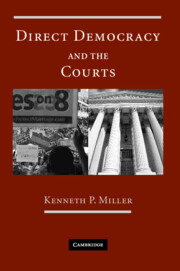Book contents
- Frontmatter
- Contents
- List of Tables and Figures
- Preface
- Introduction: A Clash of Rising Powers
- PART I THE QUEST FOR MAJORITY RULE
- PART II COUNTERING THE MAJORITY
- 3 The Counter-Majoritarian Power
- 4 The Courts at Work
- 5 Conflicts Over Rights
- 6 Conflicts Over Powers
- PART III THE MAJORITY STRIKES BACK
- Conclusion: A New Constitutional Equilibrium
- Appendix: Post-Election Initiative Invalidations
- References
- Index
- References
6 - Conflicts Over Powers
Published online by Cambridge University Press: 05 June 2012
- Frontmatter
- Contents
- List of Tables and Figures
- Preface
- Introduction: A Clash of Rising Powers
- PART I THE QUEST FOR MAJORITY RULE
- PART II COUNTERING THE MAJORITY
- 3 The Counter-Majoritarian Power
- 4 The Courts at Work
- 5 Conflicts Over Rights
- 6 Conflicts Over Powers
- PART III THE MAJORITY STRIKES BACK
- Conclusion: A New Constitutional Equilibrium
- Appendix: Post-Election Initiative Invalidations
- References
- Index
- References
Summary
Critics have also long argued that direct democracy undermines representative government. The initiative process, it is said, too easily allows fleeting majorities to alter powers of state government – or even, potentially, federal powers. This chapter examines how citizen initiatives have threatened to erode representative institutions and how, in turn, courts have responded to these threats.
CHANGING CONSTITUTIONAL DESIGN
Direct democracy's potential danger to representative government is greatest in states with initiative constitutional amendment (ICA), the process that permits citizens to propose state constitutional amendments and adopt them by simple majority vote. In the same way the ICA can limit state constitutional rights, it can erode the constitutional powers of state government.
Again, these dynamics are a sharp departure from the federal model of “higher law” constitutionalism. Any movement to modify federal institutions – for example, to abolish the Electoral College or impose term limits on members of Congress – must work its way through Article V's exacting, two-stage, super-majority amendment process. Amendments may be proposed only by a two-thirds vote of both houses of Congress or by a federal constitutional convention demanded by two-thirds of the state legislatures, while ratification requires approval of three-fourths of the states, either through their legislatures or state ratifying conventions.
Madison argued that the Article V amendment procedure was “stamped with every mark of propriety. It guards equally against that extreme facility, which would render the Constitution too mutable; and that extreme difficulty, which might perpetuate its discovered faults.”
- Type
- Chapter
- Information
- Direct Democracy and the Courts , pp. 156 - 186Publisher: Cambridge University PressPrint publication year: 2009



